| کد مقاله | کد نشریه | سال انتشار | مقاله انگلیسی | نسخه تمام متن |
|---|---|---|---|---|
| 6350313 | 1622203 | 2013 | 18 صفحه PDF | دانلود رایگان |
عنوان انگلیسی مقاله ISI
Dung beetle brood balls from Pleistocene highland palaeosols of Andean Ecuador: A reassessment of Sauer's Coprinisphaera and their palaeoenvironments
دانلود مقاله + سفارش ترجمه
دانلود مقاله ISI انگلیسی
رایگان برای ایرانیان
موضوعات مرتبط
مهندسی و علوم پایه
علوم زمین و سیارات
فرآیندهای سطح زمین
پیش نمایش صفحه اول مقاله

چکیده انگلیسی
Independently, Roselli (1939) and Sauer (1955) described and named similar fossil brood balls from the Paleogene of Uruguay (Devincenzia murguiai) and from the Quaternary of Ecuador (Coprinisphaera ecuadoriensis), respectively. In their contributions, they illustrated and described fossil brood balls characterized by the presence of a medium-sized hole piercing the wall of spherical to sub-spherical chambers. Newly collected brood balls from palaeosols of the Cangahua Formation (Ecuador), and other previously deposited in ichnological collections from Ecuador, Uruguay, and Argentina, including type material, were revised to update Coprinisphaera ichnotaxonomy. Coprinisphaera ecuadoriensis Sauer (1955) is a subjective junior synonym of Coprinisphaera murguiai (Roselli, 1939). Coprinisphaera murguiai sensu Laza, 2006 (non Roselli, 1939) is in turn a new ichnospecies named herein Coprinisphaera lazai isp. n. Additionally, a new ichnospecies, named herein as Coprinisphaera kitu isp. n.., was found in the Cangahua Formation. It is represented by a spherical to sub-spherical chamber having a discrete wall, with a crown composed of a hemispherical structure on one pole. The statistical analysis of the size of the two ichnospecies found in the Cangahua Formation suggests that C. kitu and C. murguiai may represent two stages (closed and emerged balls, respectively) of a unique original morphology (C. kitu) and producer. There are no extant dung beetle species that construct brood balls with a morphology similar to that of C. kitu. The producer of C. kitu would be the recently described fossil Phanaeini, Phanaeus violetae. Phytoliths extracted from infillings of closed C. kitu revealed that Poaceae were mostly included in the diet of the herbivores that produced the dung. Considering the vertebate fossil record for the Pleistocene Cangahua Formation, ground sloths, mastodons, and horses could have been the dung providers. The record of Tombownichnus plenus, Lazaichnus fistulosus, and Castrichnus incolumis suggests the presence of cleptoparasites and detritivores in the dung community. Cangahua sediments accumulated in a volcaniclastic, intermontane setting located at 2500-2900Â m.a.s.l. and under fluctuating syneruptive conditions. Changes in facies associations and palaeosol types enable to distinguish three stages in evolution of sedimentation and landscapes. Calcic Andisols, andic Aridisols, and andic Mollisols, in the upper section, are the pedotypes that more commonly include Coprinisphaera. The intravolcanic environments where dung beetles, and probably large herbivores, better developed were temperate, seasonal, semiarid to subhumid, grasslands and wooded grasslands. They were covered by ashfalls reworked by wind and minor volcaniclastic flows.
ناشر
Database: Elsevier - ScienceDirect (ساینس دایرکت)
Journal: Palaeogeography, Palaeoclimatology, Palaeoecology - Volume 386, 15 September 2013, Pages 257-274
Journal: Palaeogeography, Palaeoclimatology, Palaeoecology - Volume 386, 15 September 2013, Pages 257-274
نویسندگان
M. Victoria Sánchez, Jorge F. Genise, Eduardo S. Bellosi, José Luis Román-Carrión, Liliana F. Cantil,